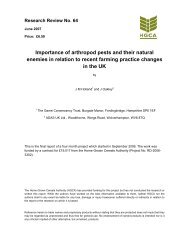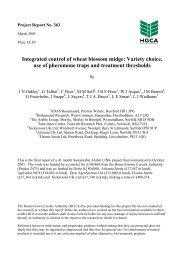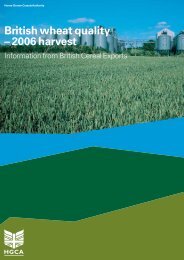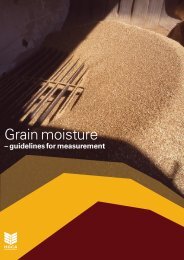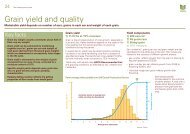BIOETHANOL GREENHOUSE GAS CALCULATOR - HGCA
BIOETHANOL GREENHOUSE GAS CALCULATOR - HGCA
BIOETHANOL GREENHOUSE GAS CALCULATOR - HGCA
You also want an ePaper? Increase the reach of your titles
YUMPU automatically turns print PDFs into web optimized ePapers that Google loves.
165. Underlying factors and calculationsA range of assumptions, default factors and conversion efficiencies have been used inthe calculator in order to generate the lifecycle GHG emissions data. Theseassumptions and factors are based on through review of the available literaturerelevant to full lifecycle assessment of biofuel production chains and on the feedbackfrom the project steering group. In order to meet accepted standards in transparencyand to clearly explain how the calculations are derived a summary is provided belowfor each of the assumptions and factors used.5.1 Basis of CalculationsThe Calculator integrates all the GHG emissions directly or indirectly attributable tothe inputs and processes involved in the different stages of a selected wheat-to-ethanolproduction chain. From this total, it subtracts credits for GHG emissions avoided bythe bioethanol co-products substitution of other GHG-generating products andprocesses e.g. DDGS used as animal feed substituting for maize gluten feed. Directemissions are those resulting from the combustion of fuels in the ethanol productionchain. Indirect emissions are those resulting from the production of the fuels used, thegeneration of imported electricity and the manufacture of material inputs andequipment used in the ethanol production chain. Indirect emissions may requireseparate lifecycle analyses to be carried out on the associated sectors or referencesystems e.g. animal feed or fossil fuel production.The Calculator does not separate out direct and indirect emissions, but calculationsare based on emissions factors which incorporate both direct and indirect emissions.Each GHG emissions factor gives the total emissions of the GHGs; carbon dioxide(CO 2 ), methane (CH 4 ) and nitrous oxide (N 2 O) associated with a product, process oractivity in a single carbon dioxide equivalent emission (CO 2 eq) figure. Derivation ofcarbon dioxide equivalent emissions is based on the concept of global warmingpotentials as specified by the International Panel on Climate Change (IPCC, 2001).The global warming potential of a gas is a measure of the relative potency of a massof that gas as a GHG compared with an equal mass of carbon dioxide over a specificperiod of time.To quantify the lifecycle GHG benefits from bioethanol production and use comparedwith petrol production and use, the Calculator compares the fuels on the basis ofenergy content. It does so, on the basis of the lifecycle emissions per unit quantity(e.g. 1 tonne, 1 litre) of bioethanol, arising from feedstock cultivation through to finalcombustion in vehicles, compared with the lifecycle emissions for a quantity of petrolwith equal energy on combustion. Issues relating to potential differences in vehicleconversion efficiency (fuel energy to mechanical energy; so called ‘tank-to-wheels’)are not dealt with except through the use of a conservative energy equivalence basis tothe calculations. Carbon dioxide emissions resulting from the combustion of thebiofuel are assumed to equal the carbon dioxide captured during crop growth and aretherefore not included.Within the tool, the emission factors used are those adopted by the Low CarbonVehicle Partnership study (LCVP, 2004). Similarly, the tool uses the LCVP emissionfactors and methodology for calculations of GHG credits. These factors and methodsare fixed in the current version of the Calculator, but could be altered in future



